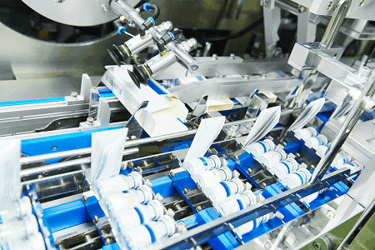New Regulations And Safety Complicate Drug Labeling
By Jerry Martin

Multinational pharmaceutical companies have for decades manufactured drugs for global distribution. Nevertheless, the task of labeling is becoming increasingly difficult and time-consuming. With new labeling requirements that can vary by country and region, drug companies are forced to either develop systems themselves to accommodate global requirements or to outsource labeling and packaging to specialists.
New GMP regulations aim to make drugs more traceable; however, best practices are still evolving, complicating implementation. Another challenge is the introduction of new labeling technologies for data tracking that differ from traditional bar codes. These include both two-dimensional (2D) bar code labeling and radio frequency identification (RFID) tags that enable remote monitoring of packages.
A single 2D bar code, which looks like a square or rectangle that contains many small individual dots, can hold a significantly greater amount of information than traditional linear bar codes and may remain legible even when printed at a small size or etched onto a product. RFID tags contain electronically stored information; electromagnetic fields automatically identify and track tags attached to objects.
No Universal Labeling Standards
While there is no global standard for serialization and information contained on a prescription drug label, there is an overall trend toward increasingly detailed documentation. When exporting drugs, manufacturers either need to consider many different labeling requirements or decentralize their labeling and packaging. Federal drug packaging and labeling requirements are written very broadly and state that drug manufacturers are responsible for ensuring that packaging material will not impact the quality or safety of the drug. However, the regulations do not provide specific directions on how to accomplish that.
Labeling requirements for prescription drugs are far more extensive than for over-the-counter products. When drugs are approved for prescription only, it’s because the healthcare provider needs to monitor the patient. Regulations for prescription drug labeling provide the prescriber with more extensive information they can use to select the drug and advise the patient.
More Information, Smaller Packaging, Less Label Space
For more than a decade, the type of information on drug labels has been expanding. In 2006, the U.S. FDA issued new regulations for label requirements with expanded prescribing information. Such detailed labeling aims to provide information to the drug prescriber or doctor more than to the consumer. The 2013 Drug Supply Chain Security Act requires pharmaceutical manufacturers to supply serialization and traceability information. While it’s up to the drug companies to figure out how to comply, it is rare for a drug company to have the expertise to comply with increasingly complicated requirements.
Some drug manufacturers have made use of digital and laser printing for labeling, allowing them to change labels accurately, quickly, and on the fly, while keeping all the required data for track, trace, and control.

Learn more about the FDA finalized guidances and draft memorandum describing what manufacturers may do (and may not do) to communicate off-label information to healthcare providers, consumers, and payors in Dale Cooke's course:
Communicating Beyond the Label: FDA’s Finalized Guidances & Updates
One of the biggest changes in labeling relates to requirements for multipage labels and booklets. Some multipage documents have extended content in several languages on the same label – something more common in Europe than in North America. Generally, consumer labeling is on the surface of a package, while a larger booklet is inside. There is an effort to make labeling information easier for patients to understand.
Changes in packaging requirements can be a result of the nature of the drugs themselves – especially the many new biotech drugs that come in smaller doses and containers. Syringes, single-dose packaging, and smaller container packaging have created new challenges as to what can fit on a label.
Another consideration for manufacturers is the change in packaging formats and their impact on labeling. The move from glass packaging to plastic, for example, presents challenges about the type of adhesives used and concerns about chemicals and adhesives that could migrate through plastic and into medicine. This is an especially important consideration for biotech drugs and sterile liquids.
Suppliers are focusing on what in the materials could possibly seep into drugs, whether they be contaminants from containers, labels, or glue. Unanticipated episodes of material seepage have prompted regulatory agencies to demand that this type of thing never happens again. For example, an anti-mold agent applied to wooden pallets migrated through the secondary packaging of a solid dose acetaminophen product and other solid-dose products. In these cases, the effects were off-odor quality issues rather than matters involving patient health reactions, but the risk of potentially greater toxic effect was recognized by manufacturers and regulators alike.
Preventing Exposures To Counterfeit Drugs
Today’s increasingly stringent labeling requirements reflect concerns about counterfeiting, tampering, and gray market distribution, all major threats to both patient safety and drug manufacturing economics. Falsified medical products may contain no active ingredient, the wrong active ingredient, or the wrong amount of the correct active ingredient, according to the World Health Organization. They are also found to commonly contain only corn starch, potato starch, or chalk.
Some substandard and falsified medical products have been toxic in nature, with either fatal levels of the wrong active ingredient or other toxic chemicals. Often produced in poor and unhygienic conditions by unqualified personnel, pathogenic bacteria or unknown impurities often contaminate these products.
Designed to appear identical to the real product, substandard drugs are difficult to detect and may cause no obvious adverse reaction. Yet, they often fail to properly treat the disease or condition for which they were intended and can lead to serious health consequences, including death.
Future Global Industry Standards Likely
In Europe, the United States, and many other countries around the world, regulations are in place that enable track and trace down to individual drug units throughout the distribution chain. Labeling has been made more secure with 2D bar codes and with cryptic information incorporated into the labels that counterfeiters might not recognize.
While government regulations are broad and unspecific, there is nonetheless talk in the pharmaceutical industry about establishing some uniform standards. It won’t be an easy task. Each company has its own ideas about best practices, time, and costs. Both suppliers and users are hopeful that this data will help satisfy the safety concerns of the FDA or other national regulatory agencies.
About The Author:
 Jerry Martin is an independent consultant to pharmaceutical manufacturers and equipment suppliers for filtration, single-use manufacturing, marketing, business development, and regulatory compliance. He was previously SVP, marketing and global scientific affairs, for Pall Life Sciences, where he served the pharmaceutical, biotech, medical device, and vaccine industries for over 37 years. He is currently chairman emeritus of the Bio-Process Systems Alliance, the single-use manufacturing trade association, and a member of the USP Expert Panel on Plastic Systems Used for Manufacturing Pharmaceutical Products. He holds an M.Sc. in microbiology from the University of Toronto.
Jerry Martin is an independent consultant to pharmaceutical manufacturers and equipment suppliers for filtration, single-use manufacturing, marketing, business development, and regulatory compliance. He was previously SVP, marketing and global scientific affairs, for Pall Life Sciences, where he served the pharmaceutical, biotech, medical device, and vaccine industries for over 37 years. He is currently chairman emeritus of the Bio-Process Systems Alliance, the single-use manufacturing trade association, and a member of the USP Expert Panel on Plastic Systems Used for Manufacturing Pharmaceutical Products. He holds an M.Sc. in microbiology from the University of Toronto.
The latest labeling technologies will be on display at the upcoming Healthcare Packaging EXPO, North America’s most comprehensive pharmaceutical event in North America, co-located with PACK EXPO International (Oct. 14-17; McCormick Place, Chicago). Produced by PMMI, The Association for Packaging and Processing Technologies, Healthcare Packaging EXPO will offer 300 exhibitors in one place from markets ranging from pharmaceuticals, biologics, and nutraceuticals to medical devices. For more information about PACK EXPO International and Healthcare Packaging EXPO, visit packexpolasinternational.com or hcpechicago.com.
